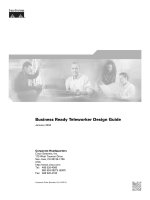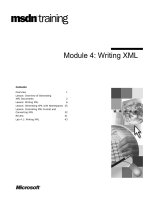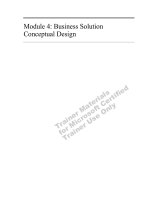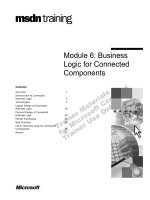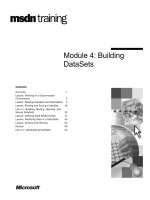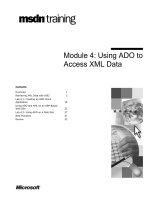Module 4: Business Solution Conceptual Design
Bạn đang xem bản rút gọn của tài liệu. Xem và tải ngay bản đầy đủ của tài liệu tại đây (507.4 KB, 48 trang )
Module 4: Business Solution
Conceptual Design
78 Module 4: Business Solution Conceptual Design
Module Overview
Module 3: A Services-Based
Approach to Solution Design
Module 4: Business Solution
Conceptual Design
Module 5: Business Solution Logical
Design
Module 6: Beginning Physical
Design
Module 1: Course Overview
Module 2: Solution Design Using the
MSF
Module 7: Selecting Solution
Technologies
Module 8: Solution Design and the
Component Object Model
Module 9: Designing Solutions with
Micros oft Techno logies
Module 1 0: Completing the Physical
Design
Module 11: Designing the
Presentation Layer
Module 12: Introduction to Functional
Specifications
Designing Business
Solutions
Conceptual Design
Basics
Activity 4.2:Inputs to Conceptual
Design
Conceptual Design
Analysis
Review
Activity 4.1: Risks of Skipping
Conceptual Design
Conceptual Design
Process
Conceptual Design
Research
Activity 4.3: Value of
Information Models
Conceptual Design
Optimization
Activity 4.4: Creating a Future-
State Usage Scenario
Module 4: Business
Solution Conceptual
Design
Module 4: Business Solution Conceptual Design 79
Module 4: Business Solution Conceptual Design 79
!
!!
!
Overview
"
Conceptual Design Basics
"
Activity 4.1: Risks of Skipping Conceptual Design
"
Conceptual Design Process
"
Conceptual Design Research
"
Activity 4.2: Inputs to Conceptual Design
"
Conceptual Design Analysis
"
Activity 4.3: Value of Information Models
"
Conceptual Design Optimization
"
Activity 4.4: Creating a Future-State
Usage Scenario
"
Review
In this module...
In this module...
You have already learned that there are three phases of design — conceptual,
logical, and physical — in the Microsoft
®
Solutions Framework (MSF) Process
Model. The first phase of the MSF Process Model is conceptual design.
Conceptual design starts during the Envisioning Phase of the MSF Process
Model, and continues through most of the Planning Phase. Since the MSF
Design Process is an evolutionary, as well as iterative, process, conceptual
design clearly sets the tone for both logical and physical design.
In this module, you will learn about the conceptual design phase of the MSF
Process Model. First, you will learn the basics of conceptual design — where it
fits into the MSF Process Model, its steps, and the tasks and outputs of the
conceptual design phase. Then you will learn about conceptual design in greater
detail through the use of examples and activities based on the Ferguson and
Bardell, Inc. case study.
After completing this module, you will be able to:
"
Explain the need for conceptual design in the process of designing a
business solution.
"
Describe the role of conceptual design in the MSF Design Process Model.
"
Describe the steps of conceptual design.
"
Develop a future-state description of a business solution created through the
conceptual design process.
"
Develop a conceptual design for a business solution from the gathered and
analyzed information.
Slide Objective
To provide an overview of
the module topics and
objectives.
80 Module 4: Business Solution Conceptual Design
80 Module 4: Business Solution Conceptual Design
!
!!
!
Conceptual Design Basics
"
Conceptual Design in the Design Process
"
Conceptual Design: The Search for Meaning
"
Goals of Conceptual Design
"
Perspective of Conceptual Design
"
Perspective Captured in Usage Scenarios
"
Clarifying Conceptual Design
"
Value of Conceptual Design
In this section...
In this section...
Although conceptual design is crucial to the solution design process, often it is
not performed, or performed improperly. Learning the basics of the process of
conceptual design will help you understand why it is a necessary part of the
design process.
In this section, you will learn the basic concepts and terminology of conceptual
design including its purpose and value during solution design.
Slide Objective
To provide an overview of
this section.
Lead-in
In this section, you will learn
about the basics of
conceptual design process
at a high level with the
following sections providing
more detail.
Module 4: Business Solution Conceptual Design 81
Module 4: Business Solution Conceptual Design 81
Conceptual Design in the Design Process
Conceptual Design
Logical Design
Physical Design
Components,
User Interface, and
Physical Database
Services and Objects,
User Interface, and
Logical Database
Scenarios
Conceptual design is the first phase of the MSF Design Process Model. Much
of conceptual design involves researching and analyzing information; however,
it also starts the design process. During conceptual design, you will determine
which business processes and activities are required and will be included in the
solution you are designing.
Slide Objective
To reinforce conceptual
design’s position in the
solution design process.
Lead-in
As you learned in Module 2,
conceptual design is the first
phase in the MSF Design
Process
82 Module 4: Business Solution Conceptual Design
82 Module 4: Business Solution Conceptual Design
Conceptual Design: The Search for Meaning
"
Definition
The process of acquiring, documenting,
validating, and optimizing business and
user perspectives of the problem and the
solution
"
Purpose
To capture, understand, and prioritize
business and user requirements in their
proper context
"
Output
A set of information models and usage
scenarios that document current and
future states of the system
Conceptual Design
Scenarios
Conceptual design requires that an effective method of understanding and
communicating with the users be established. This is accomplished by
generating scenarios.
Consider how an architect determines the needs of a client. When designing a
house, an architect will ask the client how the house will be used. In answering
this question, the client will consider the various day-to-day activities as well as
special events, such as hosting a house full of relatives. Each of the activities
the client describes might generate a scenario.
In a similar way, conceptual design is a forum in which the business and the
users present their visions and collaborate on the solution. The project team
creates scenarios to document and discuss the form of that vision. These
scenarios, in turn, verify that the project team, the business, and the users share
a common understanding that embodies the functional and informational
requirements of the system.
Slide Objective
Provide an introduction to
conceptual design.
Lead-in
Conceptual design is
considered “the search for
meaning,” because it is a
process to determine what
is wrong with the current
situation and what is needed
in a future solution.
Module 4: Business Solution Conceptual Design 83
Module 4: Business Solution Conceptual Design 83
Goals of Conceptual Design
"
Determine the business problem to be solved
"
Determine the true requirements of the business, the
customer, and the users
"
Describe the desired future state of the business
processes and activities
"
Decide if there is value in developing a solution to
enable the redesigned processes and activities
Conceptual design is about clearly understanding the problem to be solved and
framing a solution to that problem in terms that both management and users can
understand. It embodies a process for creating (or acquiring), evaluating,
documenting, and then validating what the users and business envision to be the
solution. This process embraces a set of principles and activities that provides
the basic rationale and motivation for creating (or not creating) a new system.
Conceptual design helps determine a project’s needs in context, resulting in a
view of the solution that is both process-focused and user-centric. The view is
not limited to a list of desirable functions but includes the broader context of
business processes and activities as well.
Conceptual design also formalizes the desired future state of the business
processes and activities. This future state becomes the basis for the next phases
of the design process.
Keep in mind that conceptual design does not always result in a future state for
a new solution. Often, conceptual design leads to the determination that
developing a new solution for a specific business problem is not feasible or
cost-effective.
Slide Objective
Identify and describe the
goals of the conceptual
design phase.
Delivery Tip
Without a good conceptual
design, you may end up with
a wonderful solution to the
wrong problem.
84 Module 4: Business Solution Conceptual Design
84 Module 4: Business Solution Conceptual Design
Perspective of Conceptual Design
The conceptual design
perspective is from the
point of view of the user
Business
Solution
Conceptual
Logical
Physical
Although application designers and developers agree that time should be spent
understanding the users and their tasks, in reality this part of design does not
receive the attention it should. On many projects, conceptual design is taken for
granted. A true understanding of the users requires a whole new perspective,
one that is from the point of view of the user.
What the users are really looking for is a solution that does the following:
"
Addresses their real day-to-day needs
"
Allows them to perform their tasks and work in a natural way
"
Contains the key features that they need to get the job done
"
Keeps simple tasks simple and makes complex tasks possible
Being user-centric might sound like a trivial issue, but it is critical in system
design and development. It not only means that the project team is able to plan
and develop systems that are tuned to the requirements of the users, but it also
means having an awareness of how the users view the current environment and
what they would like to see in a new system.
Whereas gathering requirements has traditionally meant compiling a list of
desirable features, in conceptual design the aim is to understand and document
the relationships between user, system, and business.
Slide Objective
To highlight that the
conceptual design of the
solution is based on the
users’ perspective of the
solution.
Lead-in
Each phase in the design
process represents a
different stage in the
evolution of the design.
Each phase also represents
stakeholders in the project.
The stakeholders
represented in conceptual
design are the users.
Module 4: Business Solution Conceptual Design 85
Module 4: Business Solution Conceptual Design 85
Perspective Captured in Usage Scenarios
"
Frames the problem and solution in a user- based
textual format
"
Creates a process-based and user-centric design
"
Documents current state as well as desired future state
"
Provides:
$
A context for the requirements
$
Details about the business and users
$
Common views and a common vocabulary
$
Design opportunities, independent of the physical
implementation
One of the methods of understanding and communicating with the users is
through usage scenarios. Usage scenarios not only enable you to document the
current state of the business process, they are also used to document the desired
solution, or future state.
The purpose of usage scenarios is to view the solution in the business context in
which it will be used and to answer the basic questions of who, what, when,
where, why, and how. The conceptual design produces a set of scenarios that
describe the necessary requirements for the proposed solution. During later
stages of development, when development and testing become entrenched in the
details of coding, these scenarios help the development team maintain focus on
the real problem to be solved.
Usage scenarios also serve to facilitate effective communications. Users,
individuals representing business processes, and the project team must develop
a shared understanding of the work problems and the impact of possible
solutions on that work. Finally, all team members need to reach agreement on
both the problem and the solution, and all should be able to understand and
communicate the implications for their individual team responsibilities.
Conceptual design is independent of development and implementation
technologies, and therefore so are usage scenarios. The primary focus is on
what the users want to do and what the business requirements do, explained in
the context of how they want to do it (but not how it might be implemented —
that comes later). Any system-related issues should be addressed from the point
of view of the business purpose.
Slide Objective
To introduce usage
scenarios and their use
during conceptual design.
Lead-in
Conceptual design is
primarily about information
models, such as usage
scenarios. These scenarios
are used to capture not only
how the necessary business
processes are being
completed now, but also
how the business and the
users want those processes
to be completed in the
future.
Delivery Tip
Usage scenarios are part of
course 1585, Gathering and
Analyzing Business
Requirements. If many
students are not familiar
with usage scenarios, spend
a few minutes explaining the
concept and assure them
that they will see an
example in an activity later
in this module.
86 Module 4: Business Solution Conceptual Design
86 Module 4: Business Solution Conceptual Design
Clarifying Conceptual Design
Conceptual design is NOT
The complete functional
specification
Details of the user interface
A definition of system components
A technology solution
But it enables you to
Develop part of the functional
specification
Design an effective user interface
See how things should work
together
Design a solution that solves the
business problem
In conceptual design, the project team attempts to understand the entire scope of
the project by identifying the proposed solution and the context in which it will
operate. The conceptual design process alone does not create the entire
functional specification, but it does provide a tremendous advantage in
constructing the functional specification by affording an opportunity to fully
understand the context of the problem to be solved.
Slide Objective
To clarify what conceptual
design really is and to
dismiss some possible
assumptions.
Lead-in
The following table should
help clarify what conceptual
design is and what it is not.
Module 4: Business Solution Conceptual Design 87
Module 4: Business Solution Conceptual Design 87
Value of Conceptual Design
"
Provides a vehicle for expressing requirements
"
Increases the value of the requirements gathered
"
Creates an opportunity for business process
optimization
"
Establishes a common set of expectations
"
Enables effective communications
Although the techniques employed during conceptual design may differ from
project to project, the end result is the same: an understanding of the true
requirements of the business and users, and a description of a future state of the
solution in the business context.
The most critical success factor in system development is user involvement.
Because conceptual design includes users as project participants, all of the
participants arrive at a consensus on the proposed system.
Along with expressing the requirements of the users, conceptual design
uncovers information about the business itself. Understanding the users and
their requirements in the context of business activities eliminates unnecessary
or extraneous requirements and increases the awareness of the remaining
requirements.
As mentioned previously, another important aspect of conceptual design is
consensus building. Everyone involved in the project should be striving toward
a unidirectional solution. Conceptual design helps to create a common set of
expectations for the project team and other stakeholders.
Finally, conceptual design enables effective communications. Conceptual
design effectively communicates its outputs by using several types of models.
Effective communication is key in developing a good solution with which
everyone agrees.
Slide Objective
To explain the benefits of a
good conceptual design and
how it helps the overall
success of the project.
Lead-in
A good conceptual design is
important to the success of
the project. The following
are some of the benefits
gained by having a good
conceptual design.
88 Module 4: Business Solution Conceptual Design
88 Module 4: Business Solution Conceptual Design
Activity 4.1: Risks of Skipping Conceptual Design
In this activity, you will take part in a class discussion to identify the possible
risks of not completing a conceptual design.
After completing this activity, you will be able to:
"
Articulate the value of conceptual design and the risks of not completing
conceptual design.
Slide Objective
To introduce the activity.
Module 4: Business Solution Conceptual Design 89
Module 4: Business Solution Conceptual Design 89
!
!!
!
Conceptual Design Process
"
Conceptual Design and the MSF Process Model
"
Conceptual Design Steps
"
Deliverables of Conceptual Design
In this section...
In this section...
Conceptual design is a process and has steps that assist you in completing this
process.
In this section, you will learn about the conceptual design process, its
deliverables, and where it fits into the MSF Process Model.
Slide Objective
To provide an overview of
this section.
Lead-in
In this section, you will learn
about the conceptual design
process and how it relates
to the MSF Process Model
for Application
Development.
90 Module 4: Business Solution Conceptual Design
90 Module 4: Business Solution Conceptual Design
Conceptual Design and the MSF Process Model
Conceptual design begins before the team reaches the Vision
Approved Milestone and baselines before the team reaches the
Project Plan Approved Milestone
Conceptual Design
Logical Design
Physical Design
Baseline
Vision
Approved
Vision
Approved
Project Plan
Approved
Project Plan
Approved
Conceptual design is the first of the three phases of design. Although no formal
starting point exists for conceptual design; it typically begins in the Envisioning
Phase, prior to the Vision Approved Milestone.
As the conceptual design process drives the business solution design, scenarios
are produced and then extended into logical design. The products of logical
design become the basis for performing physical design. Though this may
imply conducting the three phases of design in strict sequence, the phases
actually overlap. This provides greater flexibility in the design process. By
using a concurrent approach, products of one phase of design flow smoothly
into the next phase and influence the previous phase.
The conceptual design may go through several iterations while details are being
added to the functional specification through logical and physical design. As
long as crucial aspects of the business and user requirements are being
discovered, the conceptual design should be revisited. Iteration occurs until
there is consensus that the conceptual design is sufficiently developed to be
baselined. The baseline is an interim milestone and serves as a reference point
for change management.
Slide Objective
To show where conceptual
design fits in the project life
cycle.
Lead-in
As you can see from the
graphic, conceptual design
can begin prior to the Vision
Approved Milestone, during
the Envisioning Phase, and
continues through most of
the Planning Phase.
Module 4: Business Solution Conceptual Design 91
Module 4: Business Solution Conceptual Design 91
Conceptual Design Steps
Conceptual Design
Although portrayed
sequentially, these steps
are iterative and
overlapping
Conceptual
Design
Baseline
Research
Analysis
Optimization
Research Baseline
Analysis Baseline
Optimization Baseline
Conceptual design has three steps and associated baselines:
"
Research
• Obtaining answers to key questions
• Identifying key business processes and activities
• Prioritizing processes and activities
• Identifying users and creating profiles
"
Analysis
• Reviewing in-depth user and business research
• Creating scenarios to depict context, workflow, task sequence, and
environmental relationships
"
Optimization
• Improving the business process
• Validating and testing the work redesign
The optimization baseline leads to the baseline of the conceptual design.
Slide Objective
To introduce the three
activities that make up
conceptual design.
Lead-in
There are three distinct
steps in conceptual design.
92 Module 4: Business Solution Conceptual Design
92 Module 4: Business Solution Conceptual Design
Deliverables of Conceptual Design
"
Business and user requirements
"
Solution constraints
"
Information models
"
User profiles
"
Current-state usage scenarios
"
Future-state usage scenarios
At the conceptual design baseline, the project team will have the following
information: business and user requirements, solution constraints, information
models, user profiles, current-state usage scenarios, and future-state usage
scenarios.
"
The project team gathers information concerning business and user
requirements, which provides the basis for designing a solution to the
business challenge.
"
This proposed solution must work within the boundaries of the solution
constraints. By referring to these constraints, the project team can identify
potential risks that might impact the solution design. One way of identifying
risks is by detecting conflicts between requirements and constraints.
"
Information models enable the project team to present visual and narrative
versions of potentially complex business processes. These models help
identify gaps in both the information gathered and in the current workflow.
"
By creating user profiles, the project team can describe the roles and
responsibilities of the users.
"
To ensure that critical business processes are incorporated into the solution,
the project team should create current-state usage scenarios. These scenarios
describe the current interactions between users and systems.
"
The design of the business solution truly begins when the project team starts
developing the scenarios of the desired future state. These scenarios
describe the desired interactions between users and systems.
Each of these deliverables, and the process of creating them, is described in the
remainder of this module.
Slide Objective
To identify the outputs of
conceptual design.
Lead-in
At the conceptual design
baseline, a number of
deliverables will be
produced.
Module 4: Business Solution Conceptual Design 93
Module 4: Business Solution Conceptual Design 93
!
!!
!
Conceptual Design Research
"
Deliverables of the Research Baseline
"
Researching the Enterprise Architecture
"
Researching Business Processes and Activities
"
Prioritizing Business Processes and Activities
"
Researching Business Systems
and Users
"
Gathering Requirements
and Constraints
In this section...
In this section...
The first step of conceptual design is research. During this step, the project
team begins gathering data about the existing business environment. This
includes identifying current business processes, systems and applications, the
information required to accomplish business activities, and the existing
technologies and infrastructure of the organization.
In this section, you will learn about the research step of conceptual design. You
will learn how to identify and prioritize business processes and activities, how
to identify business systems and users, and how to gather business and user
requirements and system constraints.
The information presented in this section is covered in greater detail in Course
1585: Gathering and Analyzing Business Requirements.
Slide Objective
To provide an overview of
this section.
Lead-in
In this section, you will learn
about the research activity
portion of conceptual
design.
94 Module 4: Business Solution Conceptual Design
94 Module 4: Business Solution Conceptual Design
Deliverables of the Research Baseline
Task
Gather business problem-
related information
Gather requirements and
constraints
Deliverable
Information on the:
"
Enterprise architecture
"
Business processes and activities
"
Business systems and users
Business and user requirements
Solution constraints
Research
Research Baseline
Identify the inputs to conceptual design before gathering data, so that the
project team can prioritize the sources of information. This will also make the
gathered data easier to structure and document.
Slide Objective
To introduce the
deliverables of the research
activity.
Lead-in
Research in conceptual
design is all about gathering
information.
Module 4: Business Solution Conceptual Design 95
Module 4: Business Solution Conceptual Design 95
Researching the Enterprise Architecture
"
The enterprise architecture is the set of standards for:
$
The organization’s business activities
$
The applications that support those activities
$
The information required to do those activities
$
The technology and infrastructure used to provide those
applications and information
"
Recognize that an enterprise architecture always exists,
even if it has not been documented
At this stage in design, the enterprise architecture can contribute the business
perspective, which:
"
Identifies the organization’s goals and objectives.
"
Describes the organizational structure.
"
Describes the key business processes and activities.
"
Identifies relationships with customers.
"
Identifies relationships with suppliers.
The enterprise architecture, however, may often not be fully documented or
even accurate. This provides an opportunity for the project team to update the
enterprise architecture after gathering and validating the aforementioned data.
Slide Objective
To define enterprise
architecture and the need to
identify it as a source of
information for conceptual
design.
Lead-in
A key source of information
that will contribute to
conceptual design is the
enterprise architecture.
